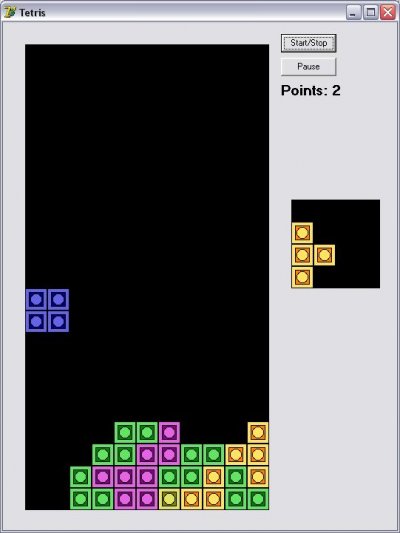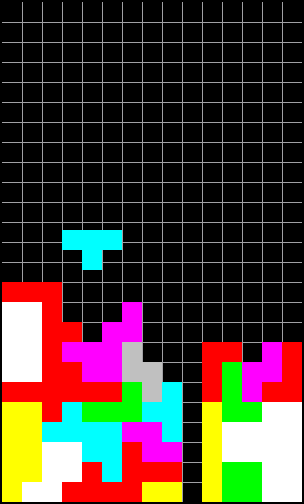
Kursovaya Rabota Tetris
Choose a level and play Tetris N-Blox online. Flash based game, no download required.
Video of an open-source Tetris Tetriminos are game pieces shaped like, shapes composed of four square blocks each. A random sequence of Tetriminos fall down the playing field (a rectangular vertical shaft, called the 'well' or 'matrix'). The objective of the game is to manipulate these Tetriminos, by moving each one sideways and/or rotating by quarter-turns, so that they form a solid horizontal line with no gaps. When such a line is formed, it disappears and any blocks above it fall down to fill the space. When a certain number of lines are cleared, the game enters a new level.

As the game progresses, each level causes the Tetriminos to fall faster, and the game ends when the stack of Tetriminos reaches the top of the playing field and no new Tetriminos are able to enter. Some games also end after a finite number of levels or lines. All of the Tetriminos can fill and clear both singles and doubles. I, J, and L are able to clear triples. Only the I Tetrimino has the capacity to clear four lines simultaneously, and this is referred to as a 'tetris'.
(This may vary depending on the rotation and compensation rules of each specific Tetris implementation. For instance, in the Super Rotation System used in most recent implementations, certain situations allow T, S, and Z to 'snap' into tight spots and clear triples.) Tetromino colors [ ] Pajitnov's original version for the computer used green brackets to represent blocks. Versions of Tetris on the original Game Boy/Game Boy Color and on most dedicated handheld games use or grayscale graphics, but most popular versions use a separate color for each distinct shape. Prior to The Tetris Company's standardization in the early 2000s, those colors varied widely from implementation to implementation.
The first version of Tetris, completed in 1984, run on an emulator of the Although not the first Tetris game to feature a new kind of Tetris, 'easy spin' (see ), also called 'infinite spin' by critics, was the first game to fall under major criticisms for it. Easy spin refers to the property of a Tetrimino to stop falling for a moment after left or right movement or rotation, effectively allowing someone to suspend the Tetrimino while thinking on where to place it.
This feature has been implemented into 's official guideline. This type of play differs from traditional Tetris because it takes away the pressure of higher level speed. Some reviewers went so far as to say that this mechanism broke the game. The goal in Tetris Worlds, however, is to complete a certain number of lines as fast as possible, so the ability to hold off a piece's placement will not make achieving that goal any faster.
Later, GameSpot received 'easy spin' more openly, saying that 'the infinite spin issue honestly really affects only a few of the single-player gameplay modes in Tetris DS, because any competitive mode requires you to lay down pieces as quickly as humanly possible.' In response to the issue, stated in an interview that infinite spin was an intentional part of the game design, allowing novice players to expend some of their available scoring time to decide on the best placement of a piece.
3d modeli landshaft. Rogers observed that 'gratuitous spinning' does not occur in competitive play, as expert players do not require much time to think about where a piece should be placed. The version designed by Spectrum Holobyte contained Russia-related images (Amiga version screenshot, 1988) Tetris was created in June 1984 by, an researcher working for the at Computer Center in Moscow. Tasked with testing the capabilities of new hardware, Pajitnov would do so by writing simple games for them. He initially considered creating a game around, which featured in puzzle games that he had enjoyed as a child, but felt that it might have been too complicated with twelve different shape variations, so the concept switched to, of which there are seven variants. The on which he was working had only a text-based display, so the tetrominoes were formed of letter characters. Realizing that completed lines resulted in the screen filling up quickly, Pajitnov decided to delete them, creating a key part of Tetris gameplay.